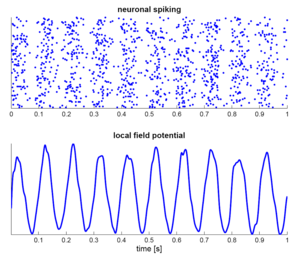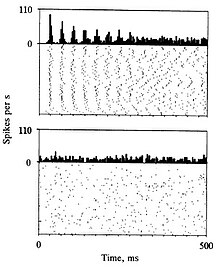
Back تذبذب عصبي Arabic Oscil·lació neural Catalan Gehirnwellen German Εγκεφαλικά κύματα Greek Ondas cerebrales Spanish نوسان عصبی Persian Neuraalinen oskillaatio Finnish Rythme cérébral French Ուղեղին Տարբեր Ալիքներուն Գործառոյթները HYW Unda cerebral Interlingua


Neural oscillations, or brainwaves, are rhythmic or repetitive patterns of neural activity in the central nervous system. Neural tissue can generate oscillatory activity in many ways, driven either by mechanisms within individual neurons or by interactions between neurons. In individual neurons, oscillations can appear either as oscillations in membrane potential or as rhythmic patterns of action potentials, which then produce oscillatory activation of post-synaptic neurons. At the level of neural ensembles, synchronized activity of large numbers of neurons can give rise to macroscopic oscillations, which can be observed in an electroencephalogram. Oscillatory activity in groups of neurons generally arises from feedback connections between the neurons that result in the synchronization of their firing patterns. The interaction between neurons can give rise to oscillations at a different frequency than the firing frequency of individual neurons. A well-known example of macroscopic neural oscillations is alpha activity.
Neural oscillations in humans were observed by researchers as early as 1924 (by Hans Berger). More than 50 years later, intrinsic oscillatory behavior was encountered in vertebrate neurons, but its functional role is still not fully understood.[3] The possible roles of neural oscillations include feature binding, information transfer mechanisms and the generation of rhythmic motor output. Over the last decades more insight has been gained, especially with advances in brain imaging. A major area of research in neuroscience involves determining how oscillations are generated and what their roles are. Oscillatory activity in the brain is widely observed at different levels of organization and is thought to play a key role in processing neural information. Numerous experimental studies support a functional role of neural oscillations; a unified interpretation, however, is still lacking.
- ^ Napoli, Nicholas J.; Demas, Matthew; Stephens, Chad L.; Kennedy, Kellie D.; Harrivel, Angela R.; Barnes, Laura E.; Pope, Alan T. (2020-03-03). "Activation Complexity: A Cognitive Impairment Tool for Characterizing Neuro-isolation". Scientific Reports. 10 (1): 3909. Bibcode:2020NatSR..10.3909N. doi:10.1038/s41598-020-60354-2. ISSN 2045-2322. PMC 7054256. PMID 32127579.
 This article incorporates text from this source, which is available under the CC BY 4.0 license.
This article incorporates text from this source, which is available under the CC BY 4.0 license.
- ^ Cite error: The named reference
ahi1990was invoked but never defined (see the help page). - ^ Llinás RR (2014). "Intrinsic electrical properties of mammalian neurons and CNS function: a historical perspective". Frontiers in Cellular Neuroscience. 8: 320. doi:10.3389/fncel.2014.00320. PMC 4219458. PMID 25408634.
© MMXXIII Rich X Search. We shall prevail. All rights reserved. Rich X Search